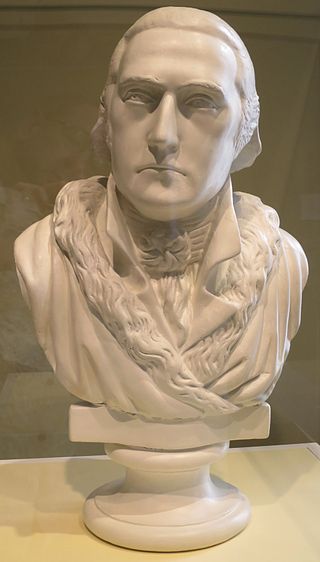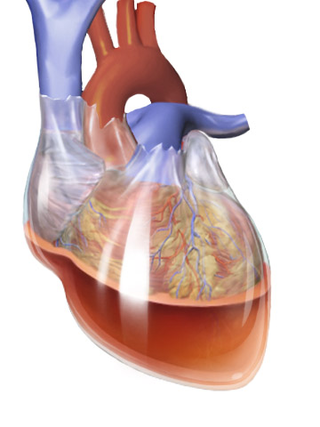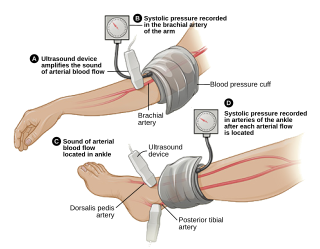Related Research Articles

George Richards Minot was an American medical researcher who shared the 1934 Nobel Prize with George Hoyt Whipple and William P. Murphy for their pioneering work on pernicious anemia.

Philip Syng Physick was an American physician and professor born in Philadelphia. He was the first professor of surgery and later of anatomy at the University of Pennsylvania medical school from 1805 to 1831 during which time he was a highly influential teacher. Physick invented a number of surgical devices and techniques including the stomach tube and absorbable sutures. He has been called the "Father of American Surgery."

Beck's triad is a collection of three medical signs associated with acute cardiac tamponade, a medical emergency when excessive fluid accumulates in the pericardial sac around the heart and impairs its ability to pump blood. The signs are low arterial blood pressure, distended neck veins, and distant, muffled heart sounds.

Morris Fishbein was an American physician and editor of the Journal of the American Medical Association (JAMA) from 1924 to 1950.
Sir Richard Peto is an English statistician and epidemiologist who is Professor of Medical Statistics and Epidemiology at the University of Oxford, England.

The ankle-brachial pressure index (ABPI) or ankle-brachial index (ABI) is the ratio of the blood pressure at the ankle to the blood pressure in the upper arm (brachium). Compared to the arm, lower blood pressure in the leg suggests blocked arteries due to peripheral artery disease (PAD). The ABPI is calculated by dividing the systolic blood pressure at the ankle by the systolic blood pressure in the arm.
An incisional hernia is a type of hernia caused by an incompletely-healed surgical wound. Since median incisions in the abdomen are frequent for abdominal exploratory surgery, ventral incisional hernias are often also classified as ventral hernias due to their location. Not all ventral hernias are from incisions, as some may be caused by other trauma or congenital problems.

The submucosa is a thin layer of tissue in various organs of the gastrointestinal, respiratory, and genitourinary tracts. It is the layer of dense irregular connective tissue that supports the mucosa and joins it to the muscular layer, the bulk of overlying smooth muscle.

Hemosuccus pancreaticus is a rare cause of hemorrhage in the gastrointestinal tract. It is caused by a bleeding source in the pancreas, pancreatic duct, or structures adjacent to the pancreas, such as the splenic artery, that bleed into the pancreatic duct, which is connected with the bowel at the duodenum, the first part of the small intestine. Patients with hemosuccus may develop symptoms of gastrointestinal hemorrhage, such as blood in the stools, maroon stools, or melena, which is a dark, tarry stool caused by digestion of red blood cells. They may also develop abdominal pain. It is associated with pancreatitis, pancreatic cancer and aneurysms of the splenic artery. Hemosuccus may be identified with endoscopy (esophagogastroduodenoscopy), where fresh blood may be seen from the pancreatic duct. Alternatively, angiography may be used to inject the celiac axis to determine the blood vessel that is bleeding. This may also be used to treat hemosuccus, as embolization of the end vessel may terminate the hemorrhage. However, a distal pancreatectomy—surgery to remove of the tail of the pancreas—may be required to stop the hemorrhage.

The history of chiropractic began in 1895 when Daniel David Palmer of Iowa performed the first chiropractic adjustment on a partially deaf janitor, Harvey Lillard. Palmer claims to have had principles of chiropractic treatment passed along to him during a seance by a long-dead doctor named Dr. Jim Atkinson. While Lillard was working without his shirt on in Palmer's office, Lillard bent over to empty the trash can. Palmer noticed that Lillard had a vertebra out of position. He asked Lillard what happened, and Lillard replied, "I moved the wrong way, and I heard a 'pop' in my back, and that's when I lost my hearing." Palmer, who was also involved in many other natural healing philosophies, had Lillard lie face down on the floor and proceeded with the adjustment. The next day, Lillard told Palmer, "I can hear that rackets on the streets." This experience led Palmer to open a school of chiropractic two years later. Rev. Samuel H. Weed coined the word "chiropractic" by combining the Greek words cheiro (hand) and praktikos.
Throughout its history, chiropractic has been the subject of internal and external controversy and criticism. According to magnetic healer Daniel D. Palmer, the founder of chiropractic, "vertebral subluxation" was the sole cause of all diseases and manipulation was the cure for all disease. A 2003 profession-wide survey found "most chiropractors still hold views of Innate Intelligence and of the cause and cure of disease consistent with those of the Palmers". A critical evaluation stated "Chiropractic is rooted in mystical concepts. This led to an internal conflict within the chiropractic profession, which continues today." Chiropractors, including D.D. Palmer, were jailed for practicing medicine without a license. D.D. Palmer considered establishing chiropractic as a religion to resolve this problem. For most of its existence, chiropractic has battled with mainstream medicine, sustained by antiscientific and pseudoscientific ideas such as vertebral subluxation.
Partial ileal bypass surgery is a surgical procedure which involves shortening the ileum to shorten the total small intestinal length.

Acetrizoic acid is a pharmaceutical drug that was used as an iodinated contrast medium for X-ray imaging. It was applied in form of its salt, sodium acetrizoate, but is no longer in clinical use.

A bone cyst or geode is a cyst that forms in bone.
Healthgrades Operating Company Inc., known as Healthgrades, is a US company that provides information about physicians, hospitals, and healthcare providers. Healthgrades has amassed information on over three million U.S. health care providers. The company was founded by Kerry Hicks, David Hicks, Peter Fatianow, John Neal, and Sarah Lochran, and is based in Denver, Colorado. Rob Draughon serves as the company's CEO. According to USA Today, Healthgrades is the first comprehensive physician rating and comparison database. The application is part of a trend in health technology in the United States towards consumer-driven healthcare.
George Henry Simmons was an English-born American physician, editor-in-chief of the Journal of the American Medical Association (JAMA) and general secretary of the American Medical Association (AMA). He edited JAMA from 1899 to 1924.

Murray Stanley Hoffman was an American cardiologist, educator and diplomate of the American Board of Internal Medicine and the American Board of Cardiovascular Disease, a Fellow of the American College of Cardiology and a member of the Council on Clinical Cardiology (CLCD) of the American Heart Association.
Medical outsourcing is a business process used by organizations like hospitals, nursing homes, and healthcare provider practices to obtain physician, nursing, healthcare technician, or other services in a managed services model.

Hobart Ansteth Reimann (1897–1986) was an American virologist and physician. Reimann made contributions to medicine with his 1938 landmark article on atypical pneumonia ; and articles on periodic disease and the common cold (1948). He was active in the testing of streptomycin against typhoid, with "the first publicly reported successful experiments."
Herbert (Chaim) Dardik was a vascular surgeon who served as the chief of vascular surgery at Englewood Hospital and Medical Center in Englewood, New Jersey, and founded that institution's first vascular surgery fellowship program in 1978. Dardik made many developments in vascular surgery, including the first tissue-engineered bypass graft used to prevent gangrene and save lower limbs. In 2017 he earned the Society for Vascular Surgery's Lifetime Achievement Award for his contributions to the profession.
References
- 1 2 3 4 Nicholson, Joe (13 August 1995). "Doc a Real Cure-iosity". Daily News.
- ↑ Press, Stephen J. (2013), History of Sports Chiropractic, New Jersey: C.I.S Commercial Finance Grp., Ltd., pp. 124–127, ISBN 9781105536830
- ↑ Sportelli, L (April 10, 2006). "Chiropractic Sports Devotees Deserve a Gold Medal!". Dynamic Chiropractic. 24 (8).
- ↑ Phil Gunby (Jan 11, 1980). "More physician involvement in future Olympic programs". JAMA . 243 (2): 103. doi:10.1001/jama.1980.03300280007004.
- ↑ Staff, H; Ibrahim, IM; Baier, R; Sprayregen, S; Levy, M; Dardik, II (December 1976). "AMA News". JAMA. 236 (25): 2859–2862. doi:10.1001/jama.1976.03270260015018. PMID 1036587.
- ↑ Dardik, I; Waitley, D (1984). Quantum Fitness: Breakthrough to Excellence. Pocket Books. ISBN 978-0-671-50903-3.
- 1 2 3 Jankowski, Lisa (30 December 2004). "In Work And Life, Ellen Macfarlane Was Epitome Of 'Grace Under Pressure'". Orlando Sentinel. Retrieved 2 August 2016.
- 1 2 DeMarco, Jerry (23 February 2013). "$1.2 million in unpaid support puts former surgeon, 76, in Bergen jail". Hackensack Daily Voice. Retrieved 2 August 2016.
- ↑ Santich, Kate (15 November 1992). "Ellen Macfarlane, Intrepid TV Sleuth Changed By Illness". Orlando Sentinel. Retrieved 2 August 2016.
- 1 2 3 State of New York Department of Health State Board for Professional Medical Conduct. "In the Matter of Irving I. Dardik, M.D. Findings of Fact as to Patient A" . Retrieved 2 August 2016.
- ↑ Querna, Betsy (26 October 2005). "Irving Dardik, wave maker". U.S. News & World Report . Archived from the original on 3 August 2009. Retrieved 16 November 2009.
- ↑ Imperiale, Nancy (9 January 1992). "Back on her feet". Chicago Tribune .
- ↑ Lewin, Roger (1995). Making Waves: Irving Dardik and His SuperWave Principle. Rodale Press. ISBN 978-1-59486-044-7.
- 1 2 Weinberger, Sharon (21 November 2004). "Warming Up to Cold Fusion". The Washington Post .
- ↑ "MU research chief wants 'cold fusion' puzzle solved - Janese Silvey - Columbia Tribune December 3, 2011". Archived from the original on December 4, 2011. Retrieved December 5, 2011.
- ↑ "Business Incubator of the University of Missouri". Archived from the original on 2012-02-10. Retrieved 2011-12-05.
- ↑ Screen Daily, "The Believers", Oct. 7, 2012
- ↑ Groves, Bob (30 August 1996). "SURGEON MUST SPEND HIS NIGHTS IN JAIL". The Record (Bergen County, NJ) . North Jersey Media Group. Archived from the original on 11 September 2016. Retrieved 2 August 2016– via HighBeam Research.
- ↑ Staff (July 1966). "AMA News". JAMA. 197 (3): 28. doi:10.1001/jama.1966.03110030026014.
- ↑ Staff (August 1976). "AMA News". JAMA. 236 (5): 431–436. doi:10.1001/jama.1976.03270050003001.
- ↑ Staff. "Giuliano Preparata Medal Winners". International Society for Condensed Matter Nuclear Science.